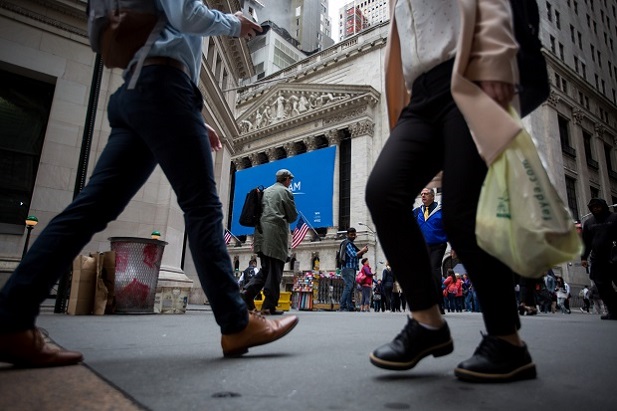 The system of 11 hospitals —which already provide free care to the uninsured — costs taxpayersmore than $2 billion a year, while scheduled federal Medicaid cutsthreaten another $1 billion or more in the next year. (Photo:Bloomberg)
The system of 11 hospitals —which already provide free care to the uninsured — costs taxpayersmore than $2 billion a year, while scheduled federal Medicaid cutsthreaten another $1 billion or more in the next year. (Photo:Bloomberg)
(Bloomberg) –New York Mayor Bill de Blasio says he's turning thecity into a model for how the nation canprovide health care to all, including the poor, theuninsured and undocumented immigrants. In doing so,he says he's saved the city's public hospitals frombankruptcy and can provide universal care for just $100 million bysteering New Yorkers away from emergency rooms and intomanaged-care clinics. Yet he may have promised more thanhe can deliver.
|The system of 11 hospitals — which already provide free care tothe uninsured — costs taxpayers more than $2 billion a year, whilescheduled federal Medicaid cuts threaten another $1 billion or morein the next year.
|Those pressures may far outstrip the savings he expects to reapfrom his proposal, according to private and government analystsfamiliar with the agency known as NYC Health + Hospitals.
|“It may show a positive cash flow compared with last year, butit certainly doesn't have surplus,” said Stephen Berger, a privateequity investor who supervised New York's budget during its 1970sfiscal crisis and in 2006 led a state health-care commission. “Itsunderused hospitals should be shut down but that's not going tohappen. Whether it can achieve financial stability remains to beseen.”
|National issue
The mayor's health-care plan is his latest effort to become aleading figure among progressive Democrats. He has made it a goalto influence the 2020 presidential campaign, and he hasn't ruledout running himself.
|Although he cast his program as unprecedented, New York'shospitals have been open to all for more than a century. What's newis his proposal to spend $100 million to hire physicians, nursesand assistants and to divert people from emergency rooms to lesscostly outpatient clinics focused on preventing illness before itrequires expensive hospitalization.
|De Blasio and other administration officials have declined todiscuss the hospital system's finances ahead of his fiscal 2020budget proposal next month. Since 2013, when de Blasio took office,the city's total funding for the hospital system has grown to about$2.1 billion from $1.3 billion, and is projected to reach $2.2billion by 2020.
|Its finances could also be worsened by an economic downturnreducing New York's tax revenue, said Charles Brecher, researchdirector at the Citizens Budget Commission, a business-supportedfiscal watchdog. “Society has a stake in this not just because weare humane, but because this safety net is crucial to our publichealth,” he said.
|Cost cuts
The turnaround effort is led by veteran hospital administratorMitchell Katz, who arrived a year ago after heading the Los AngelesHealth Agency, where he developed a reputation for cutting costsand increased revenue, enrolling 350,000 in a similar primary careprogram.
|Katz's strategy departs from predecessors who tried to downsizethe system with a goal of reducing costs and headcount throughattrition. Katz wants to expand it, with more doctors, nurses,diagnostic tests and outpatient therapies more generouslyreimbursed by private insurance, Medicaid and Medicare thanemergency room and in-patient acute care.
|Katz told city council members this month that his money-makingefforts are beginning to pay off. In the year he's been president,he said, the agency received $150 million from insurance companiesthat wouldn't have been collected in the past. This is the way “toavoid the closure scenario, of having to shrink,” he said.“Instead, let's grow and increase revenue.”
|MetroPlus
Another goal: increasing enrollment in a health insurance plancalled MetroPlus owned by the city's public-hospital system, whichde Blasio is seeking to expand to 300,000 uninsured NewYorkers.
|Katz's gambit may fail as the public hospitals operate withinsured patients choosing private hospitals. H+H's North CentralBronx Hospital had a 54 percent average occupancy in 2017. Bergerand Brecher say any plan to save the system should include closingsuch underused hospitals, a proposal that has a history of incitingso much neighborhood and union outrage, mayors, including DeBlasio, have ruled out this option.
|District 37 executive director Henry Garrido, whose unionrepresents half the 40,000 public hospital workers, says to shutdown hospitals would be a foolish giveaway of resources providingsocial safety nets to poor neighborhoods. He supports transformingtheir unused space for outpatient diagnostic tests and treatments–colonoscopies, psychotherapy, chemotherapy and physical therapy —services that have helped stabilize finances of privatehospitals.
|“This should not be about closing hospitals but using resourcesthe best way available,” Garrido says. “A system this big needstime to restructure itself. The uninsured population is not likelyto disappear any time soon.”
|READ MORE:
|2 approaches to incorporating health care inretirement planning
|Vanguard, Mercer, roll out new retiree health carecost model
|Health care costs crimping retirementconfidence
|Copyright 2019 Bloomberg. All rightsreserved. This material may not be published, broadcast, rewritten,or redistributed.
Complete your profile to continue reading and get FREE access to BenefitsPRO, part of your ALM digital membership.
Your access to unlimited BenefitsPRO content isn’t changing.
Once you are an ALM digital member, you’ll receive:
- Critical BenefitsPRO information including cutting edge post-reform success strategies, access to educational webcasts and videos, resources from industry leaders, and informative Newsletters.
- Exclusive discounts on ALM, BenefitsPRO magazine and BenefitsPRO.com events
- Access to other award-winning ALM websites including ThinkAdvisor.com and Law.com
Already have an account? Sign In
© 2024 ALM Global, LLC, All Rights Reserved. Request academic re-use from www.copyright.com. All other uses, submit a request to [email protected]. For more information visit Asset & Logo Licensing.








